-
Please Remember: Members are only permitted to share their own experiences. Members are not qualified to give medical advice. Additionally, everyone manages their health differently. Please be respectful of other people's opinions about their own diabetes management.
You are using an out of date browser. It may not display this or other websites correctly.
You should upgrade or use an alternative browser.
You should upgrade or use an alternative browser.
Group 7-day waking average?
- Thread starter Northerner
- Start date
PattiEvans
Well-Known Member
- Relationship to Diabetes
- Type 1
- Pronouns
- She/Her
Morning all and what a nasty one it is! Wind, lashing rain and thick cloud. At least it's washed the remaining bird poo off the windows.
9.6 this morning, at least it's an improvement on yesterday's 13.6. I discovered my Omnipod dangling off yesterday morning after I posted so that was probably the reason for the 13.6. Went really low after dinner last night and had a number of Dextrose + a biscuit and 1.5 hour -50% temp basal as it just wouldn't come up from the 3s. Then when it went up it stayed flat all night. Sigh!
Yorkshire puddings episode 2... Did the roast spuds in the air fryer (I was not a fan of the result!) to free up the oven for the yorkies The reserved batter had gone a bit thick in the fridge, so added a splash of milk. Put the dripping in the oven for 19 minutes @ 200C fan. Did think it hot enough (though smoke alarms did not go off - good thing, we have 3 of the darn things that all go off together) and the puds were an improvement, but a tad too brown on top. I'll get there! Once again the (cold) beef was lovely!
@TinaD I made the mistake of starting to teach hubby to cook a few months ago. I compounded it by giving him an apron which said "Head Chef" for Christmas. He now thinks he knows it all whilst still being in the elementary stream. On the bright side he is a willing helper preparing veg etc. Sorry to hear about your car... I want to rush up with supplies for you, but it's a bit too far. Hope you get sorted out soon and that the new Gardener proves to be a gem!
Well well well... what a clutch of HSs we have today! Well done @harbottle @Lily123 @Eternal422 and @MeeTooTeeTwo Some lovely houses added to the estate!
@eggyg super photos!
@ColinUK good luck with the specialist. Looking forward to CCC.
Have a good day all!
9.6 this morning, at least it's an improvement on yesterday's 13.6. I discovered my Omnipod dangling off yesterday morning after I posted so that was probably the reason for the 13.6. Went really low after dinner last night and had a number of Dextrose + a biscuit and 1.5 hour -50% temp basal as it just wouldn't come up from the 3s. Then when it went up it stayed flat all night. Sigh!
Yorkshire puddings episode 2... Did the roast spuds in the air fryer (I was not a fan of the result!) to free up the oven for the yorkies The reserved batter had gone a bit thick in the fridge, so added a splash of milk. Put the dripping in the oven for 19 minutes @ 200C fan. Did think it hot enough (though smoke alarms did not go off - good thing, we have 3 of the darn things that all go off together) and the puds were an improvement, but a tad too brown on top. I'll get there! Once again the (cold) beef was lovely!
@TinaD I made the mistake of starting to teach hubby to cook a few months ago. I compounded it by giving him an apron which said "Head Chef" for Christmas. He now thinks he knows it all whilst still being in the elementary stream. On the bright side he is a willing helper preparing veg etc. Sorry to hear about your car... I want to rush up with supplies for you, but it's a bit too far. Hope you get sorted out soon and that the new Gardener proves to be a gem!
Well well well... what a clutch of HSs we have today! Well done @harbottle @Lily123 @Eternal422 and @MeeTooTeeTwo Some lovely houses added to the estate!
@eggyg super photos!
@ColinUK good luck with the specialist. Looking forward to CCC.
Have a good day all!
Congrats to @harbottle @Eternal422 and @MeeTooTeeTwo on the HS and well as @Lily123
Lovely photos @eggyg
Lovely photos @eggyg
TinaD
Well-Known Member
- Relationship to Diabetes
- Type 2
Rushing over with supplies: a very kind thought but all is well. The boys at the garage fixed it - caliper had failed - £177 - so roast beef off this weeks menu. Mind you without Yorkies or roasted pots its only really worth doing when the family come so I can have an excuse to filch one for me. Cold beef sarnies, when here alone, being also out of the question if I am being good. Wolf thinks beef joints are an excellent idea...as long as son-in- law is not here since he has hollow legs and feels it his duty to the environment not to leave a scrap. Sadly prospective gardener a no show.Morning all and what a nasty one it is! Wind, lashing rain and thick cloud. At least it's washed the remaining bird poo off the windows.
9.6 this morning, at least it's an improvement on yesterday's 13.6. I discovered my Omnipod dangling off yesterday morning after I posted so that was probably the reason for the 13.6. Went really low after dinner last night and had a number of Dextrose + a biscuit and 1.5 hour -50% temp basal as it just wouldn't come up from the 3s. Then when it went up it stayed flat all night. Sigh!
Yorkshire puddings episode 2... Did the roast spuds in the air fryer (I was not a fan of the result!) to free up the oven for the yorkies The reserved batter had gone a bit thick in the fridge, so added a splash of milk. Put the dripping in the oven for 19 minutes @ 200C fan. Did think it hot enough (though smoke alarms did not go off - good thing, we have 3 of the darn things that all go off together) and the puds were an improvement, but a tad too brown on top. I'll get there! Once again the (cold) beef was lovely!
@TinaD I made the mistake of starting to teach hubby to cook a few months ago. I compounded it by giving him an apron which said "Head Chef" for Christmas. He now thinks he knows it all whilst still being in the elementary stream. On the bright side he is a willing helper preparing veg etc. Sorry to hear about your car... I want to rush up with supplies for you, but it's a bit too far. Hope you get sorted out soon and that the new Gardener proves to be a gem!
Well well well... what a clutch of HSs we have today! Well done @harbottle @Lily123 @Eternal422 and @MeeTooTeeTwo Some lovely houses added to the estate!
@eggyg super photos!
@ColinUK good luck with the specialist. Looking forward to CCC.
Have a good day all!
ColinUK
Well-Known Member
- Relationship to Diabetes
- Type 2
- Pronouns
- He/Him
Colin's Cultural Corner 28/3/23 pt 1
After Impressionism: Inventing Modern Art - National Gallery
This exhibition shows the progression from Impressionist painters through Post-Impressionist to Cubist, Fauvre and unashamedly "modern" Art. That said it stops in roughly 1915 with very few paintings later than that.
We start with a Cézanne, Bathers, and our attention is drawn specifically to the right hand seated figure and the shadow on her torso. This is apparently the first steps towards a less naturalistic representation of flesh and is the single brush stroke which spurs the creation of everything else here.
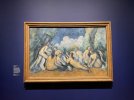
It's also clear that Cézanne had trouble painting hands and feet.
Anyway we move on from that through number of his still life's where he played with how natural looking items were arranged on unnatural surfaces. Then we have a number of works by various contemporaries of his using a variety of daubing methods of applying paint. Cue Pointillism and for me perhaps the most arresting image in the exhibition.

There's the usual Gaugin canvases including Nevermore which is being used to illustrate the artistic creation of an entirely unreal version of so called exotic life.
There's some Munch works from when he was very young including this one depicting his 17 year old sister on her death bed. He was just 20 when he painted this and it clearly show the path he's on regarding using painting to express emotion rather than reality.
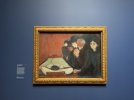
There's some Rodin sculptures, some Degas paintings (not sure why he's included in here but then I find his work quite problematic, perhaps more so than Gaugin's Nevermore) and a trio of Mondrian paintings which were completed in a five year period.
Side by side they show the refinement, the abstraction if you prefer, or distillation of essence perhaps from what's a recognisable tree, through a tree where there's no hint of realism to a depiction of the exact same tree where he's moved beyond even trying to capture the form of the tree and is (apparently) focussing on the minute planes of leaves and bark and the interplay of light and shadow to force a paradigm shift in what was acceptable from art and artists.
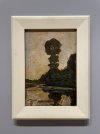
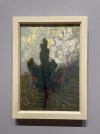
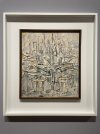
The commentary goes to great lengths to remind us that many of these paintings, including some very well known ones I didn't take pics of, were rejected by the art establishment of the time. Van Gogh sold one painting in his lifetime don't forget. There's a fair number of works by women artists of the time, contemporaries of Picasso or Van Gogh or others. None of those were well received by anyone other than perhaps artist friends of theirs and their contribution to Art is often overlooked but they have a place and an importance which is not really explored satisfactorily here.
What is here amounts to a very detailed lecture on how art styles moved on and continue to move on. Art didn't stop with the violence of WW1 but that violence is evident in the works on display, and especially in the sculpture below:
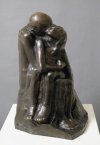
If memory serves me right it's called Lover's Embrace but there's a real sense of grief about it. You can't tell if the woman, with he head thrown back and the weight her limp limbs convey, is in a moment of ecstasy as her lover kisses her neck or if he's actually cradling a dead body.
On a general point, it was good to see a couple of Klimt's next to each other and to slot them into historical context. The white dress in one painting was designed not to be worn out and about but only to be worn to be painted in. The designer and Klimt worked together to create the gossamer like panels set out with squares of more opaque cloth so that they would suggest the form underneath. Both of these postdate the gold portrait of Adele Bloch Bauer who is the subject in the right hand painting.
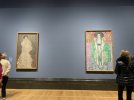
Did I enjoy it? Yes. Sort of. It was a little dry. Perhaps a little academic for my tastes but it was interesting to see things in context. Sometimes we saw the same scene painted by three artists contemporaneously and it's curious to imagine the conversations they had about who did what better than the others.
After Impressionism: Inventing Modern Art - National Gallery
This exhibition shows the progression from Impressionist painters through Post-Impressionist to Cubist, Fauvre and unashamedly "modern" Art. That said it stops in roughly 1915 with very few paintings later than that.
We start with a Cézanne, Bathers, and our attention is drawn specifically to the right hand seated figure and the shadow on her torso. This is apparently the first steps towards a less naturalistic representation of flesh and is the single brush stroke which spurs the creation of everything else here.

It's also clear that Cézanne had trouble painting hands and feet.
Anyway we move on from that through number of his still life's where he played with how natural looking items were arranged on unnatural surfaces. Then we have a number of works by various contemporaries of his using a variety of daubing methods of applying paint. Cue Pointillism and for me perhaps the most arresting image in the exhibition.

There's the usual Gaugin canvases including Nevermore which is being used to illustrate the artistic creation of an entirely unreal version of so called exotic life.
There's some Munch works from when he was very young including this one depicting his 17 year old sister on her death bed. He was just 20 when he painted this and it clearly show the path he's on regarding using painting to express emotion rather than reality.

There's some Rodin sculptures, some Degas paintings (not sure why he's included in here but then I find his work quite problematic, perhaps more so than Gaugin's Nevermore) and a trio of Mondrian paintings which were completed in a five year period.
Side by side they show the refinement, the abstraction if you prefer, or distillation of essence perhaps from what's a recognisable tree, through a tree where there's no hint of realism to a depiction of the exact same tree where he's moved beyond even trying to capture the form of the tree and is (apparently) focussing on the minute planes of leaves and bark and the interplay of light and shadow to force a paradigm shift in what was acceptable from art and artists.



The commentary goes to great lengths to remind us that many of these paintings, including some very well known ones I didn't take pics of, were rejected by the art establishment of the time. Van Gogh sold one painting in his lifetime don't forget. There's a fair number of works by women artists of the time, contemporaries of Picasso or Van Gogh or others. None of those were well received by anyone other than perhaps artist friends of theirs and their contribution to Art is often overlooked but they have a place and an importance which is not really explored satisfactorily here.
What is here amounts to a very detailed lecture on how art styles moved on and continue to move on. Art didn't stop with the violence of WW1 but that violence is evident in the works on display, and especially in the sculpture below:

If memory serves me right it's called Lover's Embrace but there's a real sense of grief about it. You can't tell if the woman, with he head thrown back and the weight her limp limbs convey, is in a moment of ecstasy as her lover kisses her neck or if he's actually cradling a dead body.
On a general point, it was good to see a couple of Klimt's next to each other and to slot them into historical context. The white dress in one painting was designed not to be worn out and about but only to be worn to be painted in. The designer and Klimt worked together to create the gossamer like panels set out with squares of more opaque cloth so that they would suggest the form underneath. Both of these postdate the gold portrait of Adele Bloch Bauer who is the subject in the right hand painting.

Did I enjoy it? Yes. Sort of. It was a little dry. Perhaps a little academic for my tastes but it was interesting to see things in context. Sometimes we saw the same scene painted by three artists contemporaneously and it's curious to imagine the conversations they had about who did what better than the others.
Northerner
Admin (Retired)
- Relationship to Diabetes
- Type 1
Good morning 🙂 4.9 for me today 🙂
Lily123
Well-Known Member
- Relationship to Diabetes
- Type 1
- Pronouns
- She/Her
Good morning - 8.7
Spiked up to 14 during the night and did a correction. It took hours to comedown. Libre is telling me I’m still 11.6 but that’s not enough if a discrepancy to change is it? It’s absolutely ruining my Time in Range
Spiked up to 14 during the night and did a correction. It took hours to comedown. Libre is telling me I’m still 11.6 but that’s not enough if a discrepancy to change is it? It’s absolutely ruining my Time in Range
Morning all. 6.6 today. Went to bed on a 6.8 but still spiked overnight. It doesn't matter what level i go to bed on i get the spike. If i up the basal i get less spikes but more lows through the day. Diabetes is a very confusing thing to deal with.
Bloden
Well-Known Member
- Relationship to Diabetes
- Type 1
Morning all. 🙂 6.9 here.
Personally, I wouldn’t change my sensor if it was 3-4 out @Lily123, especially in the morning. When I set off for my morning walk, my Libre’ll say 13-14 and my finger prick’ll say 7-8. It’s a crazy inaccurate beast, the Libre! 🙂
Wow, there’s a lot of paper shuffling with my job. Hopefully, I’ve done everything I need to before the Easter break starts on Friday. I’ll be watching my work email like a hawk until Friday!
Personally, I wouldn’t change my sensor if it was 3-4 out @Lily123, especially in the morning. When I set off for my morning walk, my Libre’ll say 13-14 and my finger prick’ll say 7-8. It’s a crazy inaccurate beast, the Libre! 🙂
Wow, there’s a lot of paper shuffling with my job. Hopefully, I’ve done everything I need to before the Easter break starts on Friday. I’ll be watching my work email like a hawk until Friday!
Robin
Well-Known Member
- Relationship to Diabetes
- Type 1
- Pronouns
- She/Her
Morning all, 9.9 here, which is an improvement on the 14.8 at bedtime, but that was with a correction of 3 units at bedtime, having done a correction mid afternoon for an unexpected high after lunch.. I think I might chamge my insulin cartridge.
ColinUK
Well-Known Member
- Relationship to Diabetes
- Type 2
- Pronouns
- He/Him
Colin’s Cultural Corner 28/3/23 pt2
Cinderella - Royal Ballet - Royal Opera House
This was just delightful. The story is the one we all know with just a few minor tweaks. Cinderella is clearly mourning her dead mother and that grief is a fairly constant presence. Or it is until she meets the fairy godmother and heads to the ball.
Lovely staging of the pumpkin becomes a coach but the mice stay as mice but just giant ones large enough to pull the carriage. Peculiarly nobody runs screaming when they see four giant mice approaching.
Cinders dances with Prince. Clock strikes midnight. Cinders scarpers and loses a sparkly slipper. Prince goes hunting door to door for the foot which fits the slipper… finds her… marries her… lives happily ever after.
The Ugly Sisters get most of the laughs of course. Played by two male dancers they are clearly based on panto depictions and owe much to the tradition of the pantomime dame. Nothing wrong with that at all and it works.
Music was sumptuous. Sets were magical. Dancing largely sublime however one on the ballerinas had an issue with her shoes and fell once and slipped twice. One of the male dancers also slipped once.
Those caused an audible gasp from the audience and it took the man a couple of beats to get back into the rhythm of things.
Ooh Cinderella making her entrance to the ball down a staircase on point was breathtaking.
Overall it was a very light, very aesthetically easy on the eye, completely unchallenging ballet with beautiful costumes, ingenious sets, great music.

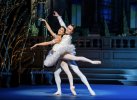
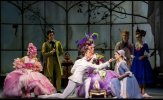
Cinderella - Royal Ballet - Royal Opera House
This was just delightful. The story is the one we all know with just a few minor tweaks. Cinderella is clearly mourning her dead mother and that grief is a fairly constant presence. Or it is until she meets the fairy godmother and heads to the ball.
Lovely staging of the pumpkin becomes a coach but the mice stay as mice but just giant ones large enough to pull the carriage. Peculiarly nobody runs screaming when they see four giant mice approaching.
Cinders dances with Prince. Clock strikes midnight. Cinders scarpers and loses a sparkly slipper. Prince goes hunting door to door for the foot which fits the slipper… finds her… marries her… lives happily ever after.
The Ugly Sisters get most of the laughs of course. Played by two male dancers they are clearly based on panto depictions and owe much to the tradition of the pantomime dame. Nothing wrong with that at all and it works.
Music was sumptuous. Sets were magical. Dancing largely sublime however one on the ballerinas had an issue with her shoes and fell once and slipped twice. One of the male dancers also slipped once.
Those caused an audible gasp from the audience and it took the man a couple of beats to get back into the rhythm of things.
Ooh Cinderella making her entrance to the ball down a staircase on point was breathtaking.
Overall it was a very light, very aesthetically easy on the eye, completely unchallenging ballet with beautiful costumes, ingenious sets, great music.



